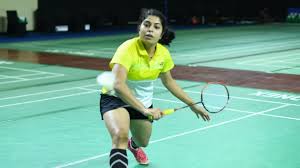Shuttler Aakarshi Kashyap’s takeaways from police training, hitting bullseye with machine guns, regaining confidence

Aakarshi Kashyap, one of India’s promising young badminton stars, recently took a detour from the usual rigors of sports training and entered an arena far removed from the shuttlecock and court — police training. The experience was not only a test of her physical and mental limits but also a revelation that helped her regain lost confidence and gain fresh perspectives on focus and discipline.
A New Challenge Beyond Badminton
For an athlete like Aakarshi, whose daily life revolves around smashing shuttlecocks and perfecting footwork, police training was an unusual yet eye-opening experience. The transition from a badminton court to a police training ground meant stepping out of her comfort zone and learning skills she had never imagined would be part of her journey.
One of the most striking elements of her training was learning to handle firearms, particularly machine guns. The idea of an athlete, especially a young woman, standing steady to aim and hit bullseyes with a machine gun might seem surprising to many. Yet, this challenge was precisely what made the experience transformative for Aakarshi.
The Art of Hitting Bullseyes with a Machine Gun
Aakarshi recalls her initial nervousness when she first held a machine gun in her hands. Unlike the racket in her hand, the weapon demanded a different kind of grip, balance, and control. She had to master breathing techniques, steady her hands, and most importantly, calm her mind — lessons that resonated deeply with her badminton practice.
Each round of shooting demanded intense concentration. The difference was stark: in badminton, the target is a fast-moving shuttle, requiring quick reflexes and agility, while in shooting, the target is static but demands calm precision and unwavering focus. The training involved repeated attempts to hit the bullseye, teaching her patience and the value of persistence.
Her instructors guided her through the nuances of aiming, posture, and trigger control. As Aakarshi gradually improved her accuracy, she felt a sense of accomplishment that boosted her morale. It was a lesson in precision and calmness under pressure — qualities she realized are critical not only in police work but also on the badminton court.
Regaining Confidence Through Discipline
Prior to the police training, Aakarshi had faced a challenging phase in her career. Like many athletes, she experienced dips in form and confidence, moments when self-doubt threatened to undermine her performance. The pressure to constantly perform at the highest level can be overwhelming, and for young athletes, regaining confidence is often a delicate, gradual process.
The police training offered her a fresh start. It demanded discipline, respect for routine, and mental toughness — aspects that naturally aligned with the demands of professional sports but presented in a different environment. Waking up early, adhering strictly to physical drills, and pushing through fatigue all reminded her of the grit needed to excel.
The discipline she cultivated there reignited her inner drive. Mastering a challenging skill like shooting helped rebuild her self-belief. Each bullseye was a small victory, proof that focus and hard work yield results. The training was a metaphor for overcoming obstacles — steady, measured progress leading to success.
Lessons That Transcend Sports
For Aakarshi, the police training was much more than a physical challenge; it was a lesson in life skills. The importance of mental focus, controlled breathing, and the ability to stay calm in tense situations are invaluable tools not only for law enforcement but for any high-pressure environment.
The experience also deepened her understanding of responsibility and resilience. Handling firearms is no trivial matter — it requires respect, caution, and maturity. These lessons added layers to her personality, reinforcing qualities that could enhance her game and life beyond sports.
She also spoke about the camaraderie and teamwork she witnessed during training. The bond between trainees, the support from instructors, and the shared challenges created a unique environment of mutual encouragement. This social aspect reminded her of the importance of support systems in an athlete’s journey.
Impact on Badminton Performance
Since returning to her badminton routine, Aakarshi feels renewed. The mental sharpness she developed during police training has translated into better focus during matches. She credits the experience for helping her manage nerves and maintain composure in crucial points.
Aakarshi’s coaches have noticed a positive change as well. Her approach to practice and competition shows more patience and a deeper sense of strategic thinking. The lessons from police training seem to have enhanced her mental resilience, making her better equipped to handle setbacks on the court.
Inspiration for Young Athletes
Aakarshi Kashyap’s story offers inspiration beyond just badminton enthusiasts. It highlights how exploring new experiences, even those seemingly unrelated to one’s profession, can foster growth and rejuvenate passion. Athletes often face intense pressure and burnout; breaking routine and challenging oneself in different ways can be a powerful antidote.
Her journey underscores the value of stepping outside comfort zones, embracing discipline in various forms, and finding confidence through mastery of diverse skills. It is a reminder that resilience is built not only through victory but also through facing unfamiliar challenges with courage.
Looking Ahead
With renewed confidence and sharpened focus, Aakarshi Kashyap is gearing up for upcoming tournaments, carrying with her the lessons of discipline, precision, and calm gained from police training. Her story resonates with anyone seeking ways to rebuild confidence and enhance performance through unconventional means.
As she continues to evolve as an athlete and individual, Aakarshi exemplifies how courage to try new things and dedication to self-improvement can lead to success on and off the court.






